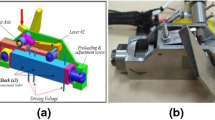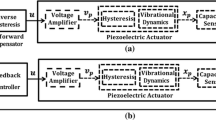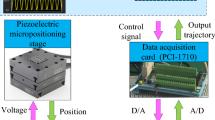Abstract
A dual-stage servo system consists of a primary coarse actuator for facilitating large motion and a secondary micro-actuator for small but precise motion to improve tracking performance. Piezoelectric micro-actuator made from lead zirconate titanate (PZT) has been a popular choice for the secondary stage. However, the advantage gained by the resolution of the secondary PZT actuator is reduced by its inherent hysteresis nonlinearity. Model based hysteresis compensation techniques are preferred due to their simplicity and fast response. Identification and modeling are two substantial parts in such model-based techniques. This paper presents a rigorous analysis and modeling of the hysteresis of PZT micro-actuator. Modified Generalized Prandtl-Ishlinskii and Coleman-Hodgdon models are studied. Identification of the model through nonlinear least square and particle swarm optimization are examined and compared. Several analyses are done through tuning of the model parameters and identification techniques. Experimental analysis and simulation results underscore the effectiveness of this modeling approach. Finally as a design example, a dual-stage simulation analysis is done to show the effectiveness of systematic modeling on hysteresis compensation.
Similar content being viewed by others
References
G. Tao, P. V. Kokotovic. Adaptive control of plant with unknown hysteresis. IEEE Transactions on Automatic Control, 1995, 40(2): 200–212.
Q. Xu. Identification and compensation of piezoelectric hysteresis without modeling hysteresis inverse. IEEE Transactions on Industrial Electronics, 2013, 60(9): 3927–3937.
A. A. Eielsen, J. T. Gravdahl, K. Y. Pettersen. Adaptive feed-forward hysteresis compensation for piezoelectric actuators. Review of Scientific Instruments, 2012, 83(8): DOI 10.1063/1.4739923.
C. Olmi, L. Y. Li, G. B. Song, et al. A novel hysteresis reducing piezoceramic amplifier. Chinese Control and Decision Conference, New York: IEEE, 2011: 716–721.
M. Bazghaleh, S. Grainger, B. Cazzolato, et al. Implementation and analysis of an innovative digital charge amplifier for hysteresis reduction in piezoelectric stack actuators. Review of Scientific Instruments, 2014, 85(4): DOI 10.1063/1.4871295.
R. C. Smith. Smart Material System: Model Development. Philadelphia: Society for Industrial and Applied Mathematics, 2005.
K. Leang, Q. Zou, S. Devasia. Feed forward control of piezoactuators in atomic force microscope systems: inversion-based compensation for dynamics and hysteresis. IEEE Control Systyem Magazine, 2009, 19(1): 70–82.
I. D. Mayergoyz. Mathematical Models of Hysteresis. New York: Elsevier, 2003.
M. Brokate, J. Sprekels. Hysteresis and Phase transitions. New York: Springer, 1996.
A. Visintin. Differential Models of Hysteresis. Berlin: Springer, 1994.
D. Habineza, M. Rakotondrabe, Y. Le Gorrec. Modeling, identification and feedf orward control of multivariable hysteresis by combining Bouc-Wen equations and the inverse multiplicative structure. Proceedings of the American Control Conference, New York: IEEE, 2014: 4771–4777.
A. Laudani, F. R. Fulginei, A. Salvini. Bouc-wen hysteresis model identification by the metric-topological evolutionary optimization. IEEE Transactions on Magnetics, 2014, 50(2): 621–624.
Y. Shan, J. Speich, K. Leang. Low-cost IR reflective sensors for submicrolevel position measurement and control. IEEE/ASME Transactions on Mechatronics, 2008, 13(6): 700–709.
G. Gu, L. Zhu. High-speed tracking control of piezoelectric actuators using an ellipse-based hysteresis model. Review of Scientific Instruments, 2010, 81(8): DOI 10.1063/1.3470117.
Y. Qin, Y. Tian, D. Zhang, et al. A novel direct inverse modeling approach for hysteresis compensation of piezoelectric actuator in feedforward applications. IEEE/ASME Transactions on Mechatronics, 2013, 18(3): 981–989.
G. Yang, M. Yang, L. Zhu. Real-time inverse hysteresis compensation of piezoelectric actuators with a modified Prandtl- Ishlinskii model. Review of Scientific Instruments, 2012, 83(6): DOI 10.1063/1.4728575.
M. Al Janaideh, J. Mao, S. Rakheja, et al. Generalized Prandtl-Ishlinskii hysteresis model: hysteresis modeling and its inverse for compensation in smart actuators. Proceedings of the 47th IEEE Conference on Decision and Control, Piscataway: IEEE, 2008: 5182–5188.
Y. Li, R. Horowitz, R. Evans. Vibration control of a PZT actuated suspension dual-stage servo system using a PZT sensor. IEEE Transactions on Magnetics, 2003, 39(2): 932–937.
M. A. Rahman, A. A. Mamun, K. Yao, et al. Particle swarm optimization based modeling and compensation of hysteresis of PZT micro-actuator used in high precision dual-stage servo system. IEEE International Conference on Mechatronics and Automation, Piscataway: IEEE, 2014: 452–457.
M. A. Rahman, A. Al Mamun. Nonlinearity analysis, modeling and compensation in PZT micro-actuator of dual-stage actuator system. Proceedings of the 11th IEEE International Conference on Control and Automation, New York: IEEE, 2014: 1275–1280.
C. Maurice. Particle Swarm Optimization. London: Wiley, 2006.
J. R. Chen, P. Mars. The feasibility of using MLP neural networks for system identification. IEE Colloquium on Neural Networks for systems: Principles and Applications, London: IEE, 1991: 1–3.
M. S. White, S. J. Flockton. Evolutionary Algorithms in Engineering Application. Berlin: Springer, 1997.
T. Kumon, M. Iwasaki, T. Suzuki, et al. Nonlinear system identification using genetic algorithm. Proceedings of the IEEE International Conference on Industrial Electronics, Control and Instrumentation, Piscataway: IEEE, 2000: 2485–2491.
K. F. Man, K. S. Tang, S. Kwong. Genetic algorithms: concepts and application. IEEE Transactions on Industrial Electronics, 1996, 43(5): 519–534.
G. Venter, J. S. Sobieski. Particle swarm optimization. AIAA Journal, 2003, 41(8): 1583–1589.
J. Voros. Modeling and identification of hysteresis using special forms of the coleman-hodgdon model. Journal of Electrical Engineering, 2009, 60(2): 100–105.
G. Guo, Q. Hao, T. S. Low. A dual-stage control design for high track per inch hard disk drives. IEEE Transactions on Magnetics, 2001, 37(2): 860–865.
L. S. Fan, H. H. Ottesen, T. C. Reiley, et al. Magnetic recording head positioning at very high track densities using a microactuator-based two-stage servo system. IEEE Transactions on Industrial Electronics, 1995, 42(3): 222–233.
M. Karaman, W. C. Messner. Robust dual stage HDD track follow control systems design for hand-off sha**. Digest of the Asia- Pacific Magnetic Recording Conference, Singapore: IEEE, 2002: DOI 10.1109/APMRC.2002.1037636.
L. Guo, D. Martin, D. Brunnett. Dual-stage actuator servo control for high density disk drives. IEEE/ASME International Conference on Advanced Intelligent Mechatronics, Piscataway: IEEE, 1999: 132–137.
D. Wu, G. Guo, T. C. Chong. Comparative analysis on resonance compensation in HDD dual-stage actuation systems. IEEE Transactions on Industrial Electronics, 2003, 50(6): 1179–1186.
B. M. Chen, T. H. Lee, K. Peng, et al. Composite nonlinear feedback control: theory and an application. IEEE Transactions on Automatic Control, 2003, 48(3): 427–439.
G. Cheng, B. M. Chen, K. Peng, et al. A Matlab toolkit for composite nonlinear feedback control. Proceedings of the 8th International Conference on Control, Automation and Robot Vision, Piscataway: IEEE, 2004: 878–883.
A. Al-Mamun, G. Guo, C. Bi. Hard Disk Drive: Mechatronics and Control. London: CRC Press, 2007.
Author information
Authors and Affiliations
Corresponding author
Additional information
This work was supported by the Singapore National Research Foundation (NRF) under CRP Award (Nos. NRF-CRP-4-2008-06, IMRE/10-1C0107).
Md. Arifur RAHMAN received his BSc degree in Electrical and Electronic Engineering from Bangladesh University of Engineering and Technology, Dhaka, Bangladesh in October2009. Currently he is working toward the Ph.D. degree at the department of Electrical and Computer Engineering, National University of Singapore, Singapore. He is attached with the Mechatronics and Automation Lab. His current research includes the design and control of high precision servo system with the application to hard disk drive. His areas of focus are resonance compensation and hysteresis control of high precision servo systems.
Abdullah Al MAMUN is currently an Associate Professor in the Department of Electricala nd Computer Engineering, National University of Singapore. He graduated from I.I.T. Kharagpur, India in 1985 and obtained Ph.D. from National University of Singapore in 1997. He has published 50 journal papers and about 60 papers in conference proceedings; he has co-authored one book. His research interests are in the areas of precision servomechanism, intelligent control and mobile robots.
Kui YAO received his bachelor degree in E.E. and Ph.D in electronic materials and devices, both from **’an Jiaotong University, China, in 1989 and 1995, respectively, and his master degree in technical physics from **dian University, China, in 1992. Currently, he is a principal scientist, and the manager of Sensor and Transducer Program, in Institute of Materials Research and Engineering (IMRE), A*STAR, Singapore. During 1998 - 1999, he worked in the Materials Research Laboratory, The Pennsylvania State University,USA. Previously, he was a postdoctoral research fellow in the Microelectronics Center at Nanyang Technological University (NTU),Singapore, during 1995-1997. His research interests cover smart materials with signal and energy conversion and storage functions, including ferroic, piezoelectric, photovoltaic, and biochemical sensing materials, material-critical sensors, actuators, transducers, and their applications.
Rights and permissions
About this article
Cite this article
Rahman, M.A., Mamun, A.A. & Yao, K. Analysis and modeling of hysteresis of piezoelectric micro-actuator used in high precision dual-stage servo system. Control Theory Technol. 13, 184–203 (2015). https://doi.org/10.1007/s11768-015-4150-2
Received:
Revised:
Accepted:
Published:
Issue Date:
DOI: https://doi.org/10.1007/s11768-015-4150-2




